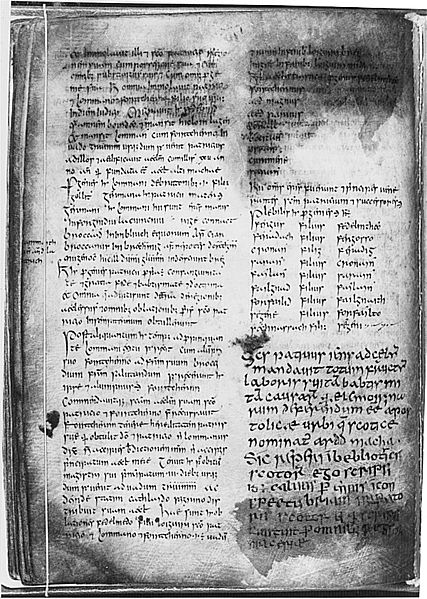Spreading from the Frontiers: Another Look at the Gospel in the Medieval Church

A page from The Book of Armagh.
Image: Wikimedia Commons
Two other re-appraisals are in order. The first of these is the Monastic movement which arose in the first half of the fourth century under Antony and Pachomius and came into its own in the fifth and sixth centuries. The other appraisal relates to the so-called Crusades. The Monastic movement has occasionally been criticized for moving away from the missionary imperative of the Church for a purer Christian life unspotted by the world’s temptations. Nothing could further from the truth as the monasteries became training grounds for the mission field. No one had a greater impact upon the outreach of the monasteries of the Western Church than John Cassian. The monasteries of Armagh in Ireland and Iona in Scotland trained those who re-evangelized Europe after the Gothic and Vandal invasions and the names of those evangelists are well-known, men as Patrick and Boniface and Augustine of Canterbury. Though the monasteries of the Orthodox Churches in the East were more of a contemplative nature, men as Basil the Great turned many of the monasteries into hospitals for the sick and infirmed, homes for the aged, and hostels for travelers. Both in the East and in the West, the monasteries also had their scriptorium in which the Bible was laboriously translated out of the Hebrew, Aramaic, and Greek into Latin and into the indigenous languages of eastern Europe and of Africa. It was the Latin language which made the Western Church catholic. The Church in the West encouraged a catholic language, that is a language that was universally spoken throughout western Europe. The Church in the East encouraged translating the Bible into the indigenous languages of the peoples of eastern Europe, Egypt, Ethiopia, and of Asia. The labor of the monks, East and West, brought the Word of God into the languages of the peoples.
The labor of the monks, East and West, brought the Word of God into the languages of the peoples.
By the time of the Crusades, the Arab themselves were on the defensive against the invading Seljuk Turks, and by 1070 the Seljuks already took over the Holy Land from the Fatimid caliph of Egypt. In A.D. 1095 Pope Urban II decided that it was time to end the Arab-Turkic Moslem dominance of the Middle-East and of the Holy Land in particular. The Council of Claremont gave their stamp of approval. In 1096 the enrollment of armies began all across western Europe to throw back the menace of the Moslems, be they Turks or Arabs. By 1098 both Edessa and Antioch had fallen to the crusaders. The following year Jerusalem fell under the Christian rule of Godfrey of Bouillon. Not all crusade leaders through the years acted like “Christians.” Several were barbaric in their actions but no more so than were the Moslems. Between 1099 and 1281, there were sparks of hope and many more sparks and flames of horrible actions. Several of the leaders of the crusading western armies were but nominal and “window-dressing” Christians in their actions which not only tarnished but soiled the Christian faith in the eyes of the conquered peoples and especially in the eyes of the Christians in the Balkan countries of Greece, Bulgaria, Serbia, Macedonia, when the fourth crusade decided to steer away from the Near East and attacked Constantinople, the capital of Orthodox Christianity. The action rocked the Christian world and drove a wedge between the Christian West and the Christian East because of the lust of the leaders to steal the wealth of the Byzantine capital. Constantinople was the wealthiest and most ornate capital city in all of Europe by virtue of its site as the entrepot of all the trade routes, maritime and overland which ended and began from there.
During the Crusades, there were sparks of hope and many more sparks and flames of horrible actions.
Category: Church History, Spring 2017


